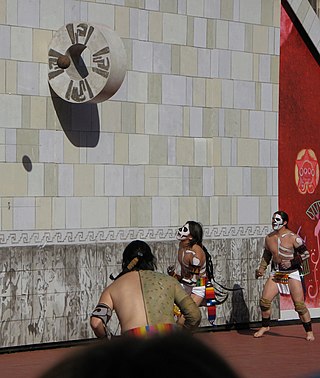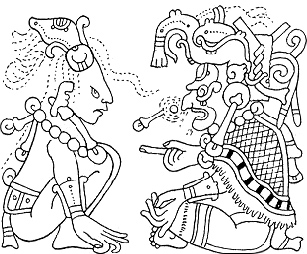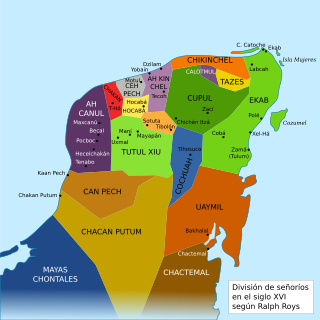
A chacmool is a form of pre-Columbian Mesoamerican sculpture depicting a reclining figure with its head facing 90 degrees from the front, supporting itself on its elbows and supporting a bowl or a disk upon its stomach. These figures possibly symbolised slain warriors carrying offerings to the gods; the bowl upon the chest was used to hold sacrificial offerings, including pulque, tamales, tortillas, tobacco, turkeys, feathers, and incense. In Aztec examples, the receptacle is a cuauhxicalli. Chacmools were often associated with sacrificial stones or thrones. The chacmool form of sculpture first appeared around the 9th century AD in the Valley of Mexico and the northern Yucatán Peninsula.

The Toltec culture was a pre-Columbian Mesoamerican culture that ruled a state centered in Tula, Hidalgo, Mexico, during the Epiclassic and the early Post-Classic period of Mesoamerican chronology, reaching prominence from 950 to 1150 CE. The later Aztec culture considered the Toltec to be their intellectual and cultural predecessors and described Toltec culture emanating from Tōllān[ˈtoːlːãːn̥] as the epitome of civilization. In the Nahuatl language the word Tōltēkatl[toːɬˈteːkat͡ɬ] (singular) or Tōltēkah[toːɬˈteːkaḁ] (plural) came to take on the meaning "artisan". The Aztec oral and pictographic tradition also described the history of the Toltec Empire, giving lists of rulers and their exploits.

Mayapan is a Pre-Columbian Maya site a couple of kilometers south of the town of Telchaquillo in Municipality of Tecoh, approximately 40 km south-east of Mérida and 100 km west of Chichen Itza; in the state of Yucatán, Mexico. Mayapan was the political and cultural capital of the Maya in the Yucatán Peninsula during the Late Post-Classic period from the 1220s until the 1440s. Estimates of the total city population are 15,000–17,000 people, and the site has more than 4,000 structures within the city walls, and additional dwellings outside.

The Mesoamerican ballgame was a sport with ritual associations played since at least 1650 BC by the pre-Columbian people of Ancient Mesoamerica. The sport had different versions in different places during the millennia, and a modernized version of the game, ulama, is still played by the indigenous populations in some places.

Uxmal is an ancient Maya city of the classical period located in present-day Mexico. It is considered one of the most important archaeological sites of Maya culture, along with Palenque, Chichen Itza and Calakmul in Mexico, Caracol and Xunantunich in Belize, and Tikal in Guatemala. It is located in the Puuc region of the western Yucatán Peninsula, and is considered one of the Maya cities most representative of the region's dominant architectural style. It has been designated a UNESCO World Heritage Site in recognition of its significance.

The Itza are a Maya ethnic group native to the Péten region of northern Guatemala and parts of Belize. The majority of Itza are inhabitants of the city of Flores on Lake Petén Itzá, and nearby portions of Belize where they form an ethnic minority.

Augustus Henry Julian Le Plongeon was a British-American archeologist and photographer who studied the pre-Columbian ruins of America, particularly those of the Maya civilization on the northern Yucatán Peninsula. While his writings contain many notions that were not well received by his contemporaries and were later disproven, Le Plongeon left a lasting legacy in his photographs documenting the ancient ruins. He was one of the earliest proponents of Mayanism.

Jacinto Canek or Jacinto Uc de los Santos, was an 18th-century Maya revolutionary who fought against the Spanish in the Yucatán Peninsula of New Spain.

Maya architecture spans several thousands of years, several eras of political change, and architectural innovation before the Spanish colonization of the Americas. Often, the buildings most dramatic and easily recognizable as creations of the Maya peoples are the step pyramids of the Terminal Preclassic Maya period and beyond. Based in general Mesoamerican architectural traditions, the Maya utilized geometric proportions and intricate carving to build everything from simple houses to ornate temples. This article focuses on the more well-known pre-classic and classic examples of Maya architecture. The temples like the ones at Palenque, Tikal, and Uxmal represent a zenith of Maya art and architecture. Through the observation of numerous elements and stylistic distinctions, remnants of Maya architecture have become an important key to understanding their religious beliefs and culture as a whole.

The traditional Maya or Mayan religion of the extant Maya peoples of Guatemala, Belize, western Honduras, and the Tabasco, Chiapas, Quintana Roo, Campeche and Yucatán states of Mexico is part of the wider frame of Mesoamerican religion. As is the case with many other contemporary Mesoamerican religions, it results from centuries of symbiosis with Roman Catholicism. When its pre-Hispanic antecedents are taken into account, however, traditional Maya religion has already existed for more than two and a half millennia as a recognizably distinct phenomenon. Before the advent of Christianity, it was spread over many indigenous kingdoms, all with their own local traditions. Today, it coexists and interacts with pan-Mayan syncretism, the 're-invention of tradition' by the Pan-Maya movement, and Christianity in its various denominations.

Sylvanus Griswold Morley was an American archaeologist and epigrapher who studied the pre-Columbian Maya civilization in the early 20th century. Morley led extensive excavations of the Maya site of Chichen Itza on behalf of the Carnegie Institution and published several large compilations and treatises on Maya hieroglyphic writing. He also wrote popular accounts on the Maya for a general audience.

The Sacred Cenote is a water-filled sinkhole in limestone at the pre-Columbian Maya archaeological site of Chichen Itza, in the northern Yucatán Peninsula. It is located to the north of Chichen Itza's civic precinct, to which it is connected by a 300-metre (980 ft) sacbe, a raised pathway.

Hunac Ceel Cauich was a Maya general from Telchaquillo who conquered Chichen Itzá and founded the Cocom dynasty. While the rulers of Chichen Itzá were in part descendants of Toltec outsiders who might have been disliked for being foreign oppressors or the war a simple one of conquest, the Maya history attributes the cause of the war to the theft of a wife of a powerful ruler by a power lord.

Chichén Itzá was a large pre-Columbian city built by the Maya people of the Terminal Classic period. The archeological site is located in Tinúm Municipality, Yucatán State, Mexico.
Chichen Itza and Tula have numerous architectural similarities in a number of their constructions. This Toltec-Maya connection is widely considered powerful, unprecedented, and unique in Mesoamerica. Unlike most Maya sites, some of Chichen Itza's buildings have the traits of the Toltecs, a historically powerful indigenous group from modern-day Mexico. The explanation of these similarities is a point of controversy among the scholars of the Toltec and Maya fields. Certain historical records caused many early scholars of the region to assume that a Toltec invasion from Tula, Hidalgo, usually placed in the ninth or tenth centuries, was responsible for a new wave of Mexican-style Maya buildings after the rest of the buildings in Chichen Itza were built. Other historical accounts imply a migration from Tula to Chichen Itza. An account of the Tula records a ruler of the Toltecs travelling east, which, paired with another account of Chichen that records a ruler from the west coming and teaching the Maya of that city many things, supported a direct influence of the Toltecs on the Maya around 900–1000 A.D. However, recent radiocarbon dating suggests that Chichen Itza's ‘mexicanized’ and pure Maya constructions were built at the same time, and that both were built prior to any recorded Toltec invasion, and previous to the banishing of the semi-historical ruler. The precise connection between these two nations is unknown, and fiercely contested among scholars of Toltecs and Maya, but it is not disputed that no other counterparts to these two cities are found in the 800 mile distance between them. Established contradicting theories and a lack of information cause the precise relationship between Chichen Itza and Tula, Hidalgo to be fervently contested.

Ah Kin Chel was the name of a Maya chiefdom or Kuchkabal of the northern Yucatán Peninsula, before the arrival of the Spanish conquistadors in the 16th century.

Balankanche is an ancient Maya cave site lying at short distance from the archaeological Maya-Toltec city of Chichen Itza, Yucatan. For more than two thousand years, it has been the focus of rituals dedicated to the Maya rain god, Chaac, and, in the Post-Classic period, also to his Toltec counterpart, Tlaloc. The cave complex was visited by Edward Thompson and Alfred Tozzer in 1905 and has since 1932 been explored and studied by various Mexican and US scholars. Small buildings and platforms surrounded the cave's entrance; inside, stairs, walls, altars and ritual displays of ceramics and small stone implements were discovered. The site has been made accessible for tourists.

The League of Mayapan was a confederation of Maya states in the Postclassic period of Mesoamerica on the Yucatan peninsula.
The Toltec Empire, Toltec Kingdom or Altepetl Tollan was a political entity in modern Mexico. It existed through the classic and post-classic periods of Mesoamerican chronology, but gained most of its power in the post-classic. During this time its sphere of influence reached as far away as the Yucatan Peninsula.
Chac Chel is a powerful and ancient Mayan goddess of creation, destruction, childbirth, water, weaving and spinning, healing, and divining. She is half of the original Creator Couple, seen most often as the wife of Chaac, who is the pre-eminent god of lightning and rain, although she is occasionally paired with the Creator God Itzamna in the Popol Vuh, a recording of the myths of the highland Maya. This highlights her importance, as dualities such as male/female and husband/wife were extremely important to the Maya, and one cannot function without the other. Chac Chel is also called Goddess O by many Mayanists and she is the aged, grandmotherly counterpart to the young goddess of childbirth and weaving, Ix Chel. Most popular in the Late Classic and Postclassic Periods, she is most often depicted in scenes in the Dresden Codex and Madrid Codex. Depictions of her, and burial goods related to her, have also been found in Chichen Itza, the Balankanche Cave near Chichen Itza, Tulum, The Margarita Tomb in Copan, and in Yaxchilan.














